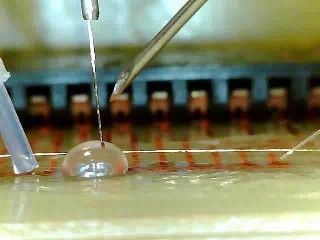Aug 20 2015
Scientists from Tallinn University of Technology (TUT) have devised a unique technology for creating microdroplets suitable for portable automatic analytical devices in various fields from internal security to environmental monitoring and space research. The Estonian Patent Office has registered the invention as a utility model.
 Unique technology for creating microdroplets suitable for portable automatic analytical devices
Unique technology for creating microdroplets suitable for portable automatic analytical devices
The invention in the field of chemistry converts any fluid into microdroplets on a fluidic microchip in order to analyse its composition and properties. The purpose of the invention is to minimise the overall size of the extract droplets generator and to improve the process of directing droplets of different sizes onto a fluidic microchip, as the technologies used so far could not be used in mobile analytical devices due to their size and a large number of elements. The invention allows minimising analysers currently the size of a suitcase down to the size of a mobile device that fits in the palm of a hand. The technology was developed by Director of the Department of Chemistry of TUT Professor Mihkel Kaljurand together with Associate Professor Maria Kuhtinskaja, senior research scientist Merike Vaher and research scientist Jelena Gorbatšova of the Chair of Analytical Chemistry of the same Department.
According to Professor Mihkel Kaljurand, the invention developed at the TUT Faculty of Science, Department of Chemistry belongs to the field of digital microfluidics aimed at programming the motion of miniature chemical droplets. “In essence this is a “chemical” analogue of a microprocessor,” Kaljurand says. “Just as microprocessors brought about a new era in information technology, a similar development in the handling of chemicals will hopefully result in a leap in quality in biological and chemical experiments.”
So far microfluidics experiments and applications have been conducted by placing chemical droplets on analytical platforms manually – while potentially acceptable at a research laboratory, this approach is not suitable for practical applications or automatic devices. The invention by the scientists at TUT, however, uses a computer programmable micropump to pump liquid through a capillary tube of a suitable size resulting in droplets of the required size forming at the tip of the tube. An electrical field allows transporting the liquid droplet to a platform of microfluidics that therefore makes it possible to build miniature and portable automatic analysers.
According to Professor Mihkel Kaljurand, the device developed at the TUT Department of Chemistry is essentially a prototype of a smart sensor applicable from internal security to environmental monitoring. “Although we demonstrated our idea in detecting biological pollution through analysing soil extracts, the invention can be used to develop any autonomous, automatic and miniature analysers,” he explains. “For example, it would be possible to send an analyser based on microfluidics to analyse the soil on Mars where the generation of liquid droplets must be completely automatic and programmable.”
The prototype of the new device will be completed at the TUT Department of Chemistry by autumn. At the moment the commercial use of the invention is not yet clear, as the technology requires further development and application research. Financial support for this has been granted by the European Space Agency, yet funding from various internal security and military research programmes has also been applied for. “Programming droplets is an extremely recent matter and so far, everything is still at the level of scientific publications,” the Director of the Department of Chemistry says. “To our knowledge, two small US businesses use a similar technology of programming droplets, yet they are in the phase of looking for investors and demonstrating the possibilities of the method as well. Commercial devices are only offered by a single company, however they place droplets on a platform manually, which is not a suitable solution for portable analysers.”